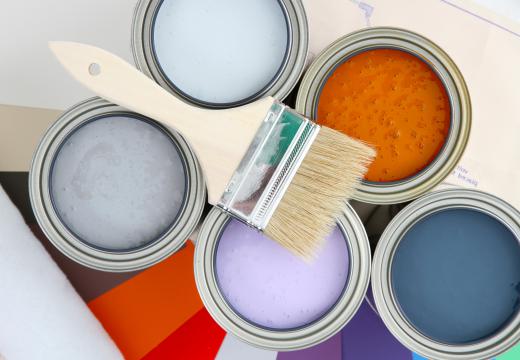An adhesive primer is product designed to improve the effectiveness of an adhesive, and is basically used to pre-treat the substances that are about to be attached together. It’s particularly popular with porous surfaces that might otherwise absorb the adhesive, and is also used frequently in very low temperature situations. It’s often hard for even the strongest industrial glues to work well in environments that are consistently below freezing, and using a primer can help construction workers and others get better results. Most primers are latex-based, and usually come as either a spray or a paint. They’re normally fairly easy to use, though people often need to take care to be sure the area is thoroughly cleaned and dry before beginning the application.
Basic Concept

Permanent adhesive products are widely used in a number of different settings, from crafts to building construction. Their main goal is to stick things together in such a way that they can’t be removed, at least not easily. Many of the strongest adhesives are designed to work with virtually any set of surfaces, but different conditions can mean that they aren’t always as effective as they might otherwise be. This is where primers come in. Primers help prepare the surfaces for the bonding agents that are coming, and can improve the conditions so that the adhesives are more powerful and work better.
One of the most common uses for adhesive primers is when binding one or more porous substances. Permanently adhering nearly anything to a porous substance is often really difficult. The problem is that, because the substrate is porous, it will absorb the adhesive and shorten the usable life of the carpet, linoleum, or other material that should remain glued down for a long time. Primers are used to increase the bonding quality of any adhesive, whether it is pre-applied, as with peel-and-stick tile, or if it must be spread, as with many types of carpeting.
Core Properties
The vast majority of primers on the market are made of latex. Almost all are water-based, and are normally designed to dry quite quickly. Depending on the ambient air temperature and the relative humidity, dry times range between 30 minutes and three hours. Substrates can be either vertical or horizontal, and include drywall, wood, plaster, masonry, concrete, wood and wood underlays, and poured-in-place gypsum subfloors.
General Usage Instructions
The area that will be primed should be ready to go before the primer is applied to the substrate. This means that the area to be primed, the primer, and the adhesive should be kept at or above 65°F (18.3°C) for at least 48 hours before and 48 hours after the primer and adhesive are installed. This will ensure that the primer dries evenly, and that the adhesive itself will dry correctly. Warm materials bond to adhesive more readily than do cold materials, which means that acclimatizing the environment and materials is also really important.
When applying adhesive primer, a short nap paint roller or a coarse fiber brush should be used. If puddles form during application, they should be rolled or brushed through so they will not become a bonding issue when the adhesive is applied. In nearly all cases the primer should be used at full strength, and tools can be cleaned with warm water.
Considerations Before Getting Started
The amount of coverage that will be provided with a given amount of adhesive primer will vary depending on the porosity and the smoothness of the substrate, but there are still some things users can do before application to help improve their results. Rougher substrates should be smoothed as much as possible with a patching and leveling compound. The compound should be dried and cured according to the manufacturer’s recommendations getting started with the primer.
It’s also really important to be sure the substrate is clean. This means that it is free of any kind of surface contaminants that will prevent the primer from working at its ideal level. Any dust, dirt, wax, polish, paint, oil, grease, or other contaminants that will interfere with effective material bonding should be removed. The substrate must also be in good, usable condition.
